Rebranding in a crisis
Rebranding in a crisis
- Crisis takes many forms
- How to develop a crisis management brand strategy
- Execute your rebrand
- Key takeaways
For Malaysia Airlines, a 67-year-old government-owned airline, the beginning of 2014 seemed like a nightmare too improbable to be real. On March 8, Malaysia Airlines Flight 370 lost contact with air traffic control shortly after taking off from Kuala Lumpur and disappeared from military radar altogether. Then on July 17, Malaysia Airlines Flight 17 was shot down while traveling over Ukraine.
In total, the tragedies resulted in a staggering loss of life. 537 people died, and the remains of Flight 370 were never found. And it didn't take long for conspiracy theories to take hold in the media, particularly after it was discovered that two passengers on Flight 370 were traveling under false passports.
The events were devastating for the victims' families, and the damage to Malaysia Airlines' brand was potentially irreversible. The company's hand was forced; they had to consider rebranding the airline. The scenario raised some compelling questions: When should a company rebrand in the wake of a crisis? And how do you rebrand in a way that's both sensitive to the situation and effective for the business?
Crisis takes many forms
When crisis occurs, it can feel like the end of the world, the air being sucked out of your brand's lungs. But it's worth remembering that all enduring brands will eventually face some form of crisis. While it's important not to downplay what happened, it's equally important not to let the event cause you to act irrationally in the heat of the moment.
"Crisis is inevitable for every brand, at every stage of growth," says Michael Gaizutis, founder of RNO1. "While rebranding can usually be a quick win, our tribes are much smarter than we think and very in tune with what companies will do and why they do such things. The key is to stay authentic; be true to your brand and core values."
While a company's brand and core values should guide its actions — particularly in the face of crisis — rebranding is just one strategy that companies have at their disposal. In most instances, rebranding should be a last resort; rebranding itself is not a crisis management strategy.
For example, Chipotle Mexican Grill faced a crisis in late 2015 when more than 60 cases of E. coli were linked to their restaurants. The brand addressed the outbreaks head on, implemented a substantial crisis management and public relations response, and committed their stores to enhanced food safety measures.
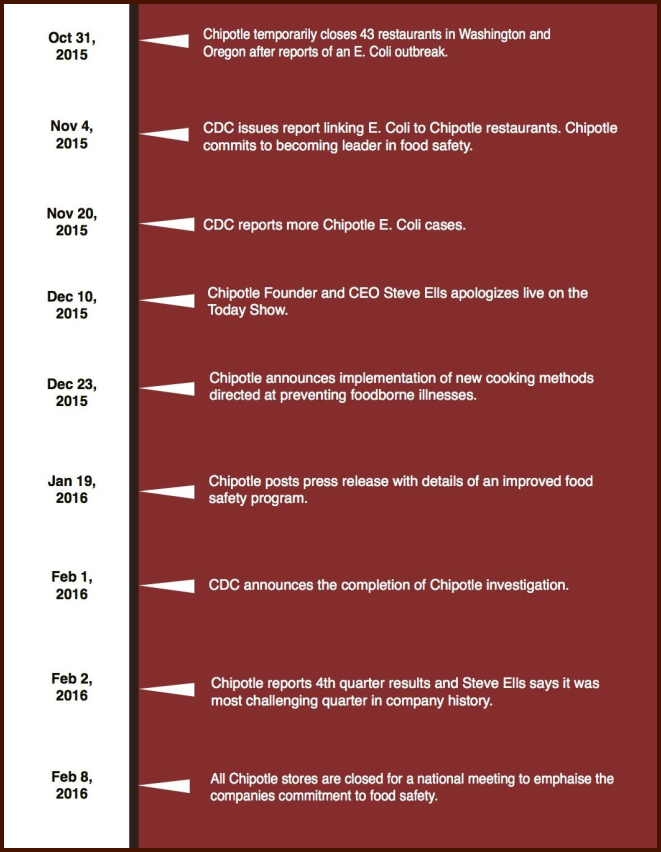
The tactics were effective, and Chipotle has made a full recovery, but their brand remained unchanged throughout. Let's look at some specific examples and circumstances where a rebrand was required in order to move beyond a crisis.
When tragedy strikes
For Malaysia Airlines, tragedy took the form of a plane crash. For Dauphin Island, Alabama, tragedy struck unexpectedly in the form of an oil spill which caused an environmental disaster. In both cases, the brands immediately became the antithesis of what they wanted to be — nobody wants to fly on an unsafe airline or vacation on a beach resort polluted by oil.
Dauphin Island, Alabama
In early 2010, Alabama's Gulf Coast had made it out of the recent recession in pretty good shape — rental bookings were actually beginning to trend slightly upward. But then BP's Deepwater Horizon oil drilling rig exploded just 100 miles off the coast of Dauphin Island, spilling more than 4 million gallons of oil into the Gulf of Mexico. The accident was devastating for the tourism-driven economy in the area: Mayor Jeff Collier estimated that 95% of the island's vacation bookings were canceled immediately following the news of the spill.
While Dauphin Island was not to blame for the accident (British Petroleum was), they were left to deal with the consequences and aftermath of the accident. But for some brands, crises are self-inflicted.
When a company founder, executive, or spokesperson screws up
Madonna and Pepsi. Gilbert Gottfried and Aflac. Jared and Subway. It's commonplace that brands have to pick up the pieces when an executive or spokesperson screws up.
But Livestrong and Papa John's faced a particularly challenging assignment: changing the perception of a brand that's intimately linked to its founder.
Livestrong Foundation
Since 2011, agency Rigsby Hull has been responsible for the brand image and communications of Lance Armstrong's Livestrong Foundation. But the agency's work became exponentially harder in 2012, when Armstrong — a seven-time Tour de France winner — finally admitted to using performance-enhancing drugs throughout his career. He was immediately stripped of his medals and resigned from the foundation, an organization that now appeared to the public as having been built on an ethos of lies.
"The key rule of building a strong brand is to have a compelling, authentic, and credible brand promise, and to defend it," says Simon Bassett, Managing Director of EMR. "Livestrong's brand promise was built on determination in the face of adversity. So the narrative went, it was determination that helped Armstrong recover from cancer and go on to win a record seven Tour de France titles."
When Armstrong admitted to using performance-enhancing drugs, the rug was pulled out from under the foundation. The narrative was a lie: it wasn't Armstrong's determination in the face of adversity that had propelled him to his Tour de France titles, but instead illegal doping. The authenticity of Armstrong's story and legacy disappeared overnight.

Media outlets from NBC to The Wall Street Journal speculated that Livestrong would have to rebrand in order to survive and distance the foundation from their disgraced founder. The decision was made much more difficult by the strong brand equity the foundation had already developed: the foundation's yellow wristbands had become an instantly recognizable part of popular culture. The brand now had to publicly distance itself from Armstrong and clarify its positioning for the future — all without losing its existing brand equity.
Next, we'll look at the steps you can take to better handle your next brand crisis.
How to develop a crisis management brand strategy
Consumers don't blame brands for situations that are out of their control — but they do blame them for not having a crisis management strategy. When a brand crisis occurs, much of the organizational impact will depend on how you respond to the circumstances. Follow these guidelines to address the crisis most effectively.
- Address the issue immediately — If your brand fails to address the crisis immediately, frustration, anger, and media attention will mount. Instead, address the crisis directly with a focus on showing empathy and being human rather than hiding behind a corporate guise. "Publicly addressing the issue head-on and presenting your intent to improve helps you get out in front of the issue and can reduce scrutiny and make your rebrand more successful," says Bernard May, Founder & CEO of National Positions.
- Authentically look for who is at fault — When a crisis occurs, you need to identify who is at fault — particularly if your company is to blame. If your brand is responsible for the crisis, you must own up to your mistakes and make it clear what corrective measures will be taken to safeguard against a similar event happening again.
- Don't move on too quickly — While moving on is a necessary step in dealing with any crisis, don't try to distance your brand from the situation too quickly. Doing so can lead to the perception that you're avoiding responsibility and can have negative long-term consequences — particularly in a situation like Malaysia Airlines encountered where fatalities were involved. "A brand can almost stand as a memorial for people who have died and I think moving on too fast and trying to disassociate itself from its old identity could be misconstrued as it wanting to disassociate from any responsibility, and that doesn't bode well for the organisation's values," says Rebecca Gudgeon, Managing Director at Grayling.
- Identify immediate actions — In the face of a crisis, it's likely that some sort of action must immediately occur, whether it's the termination of somebody responsible for the event, stopping an oil leak, or simply putting out the fire. You've already addressed the issue directly, identified who is at fault, and checked yourself from moving on too quickly — now is the time to take action. For example, Subway immediately suspended their relationship with spokesperson Jared Fogle upon learning of a criminal investigation against him for child pornography charges.
- Decide whether or not to rebrand — Once you've taken whatever immediate action is needed, you can begin to consider whether or not a rebrand is needed. Has the damage to your brand been so irrevocable that rebranding is your only remaining option? Seek counsel from your internal team, your existing customers, as well as prospects whenever possible.
- Consider a name change — If a rebrand is required, start by assessing whether or not the crisis is so severe that a name change is in order. You'll need to consider how much brand equity your current name has built up over the years, the cost of changing your name on all customer-facing materials, as well as your domain name, web presence, and rankings in search engine results. For example, Overstock.com lost 61% of its web traffic when it rebranded its domain from Overstock.com to O.co. "O.co was my bad call," said CEO Patrick Byrne.
- Go back to the basics — Your brand name aside, you'll need to consider the elements of your brand that you hope to retain versus those that you wish to discard or distance yourself from in light of the crisis. For example, Papa John's decided to distance themselves from John Schnatter while retaining their focus on "Better Ingredients."
- Create your action plan — Deciding to rebrand is not enough: you need to prove to the public that your new brand is meaningful. Start by creating a list of specific actions that your new brand will take to begin living your new brand promise. For example, Uber hired a Chief Diversity and Inclusion Officer and launched their diversity page and communities after rebranding in the wake of sexual harassment and discriminatory practices scandals.
By following these steps, you'll have a crisis management brand strategy to help you mitigate the impact of the crisis as much as possible. Then, all you'll have to do is execute on your rebrand. Let's take a closer look at the moves the companies we've discussed made in the wake of crisis.
Execute your rebrand
A hero-turned-fraud, a racist, and an oil-covered beach — the companies we've discussed all faced serious crises. Here's a closer look at how each one rebranded to address the unfortunate circumstances at hand.
Dauphin Island, Alabama
After years of clean-up and litigation, British Petroleum (BP) awarded a payout to Dauphin Island in an effort to boost tourism. Stamp Destinations was hired to help with the rebrand. The agency started by refreshing the island's logo, with a new mark that was younger and more fun. Also included was a new tagline, "Sunset capital of Alabama," that diverted attention away from the polluted waters (attributes of the brand they decided to leave behind) and instead focused on one of the island's other selling points, great sunsets (a core attribute they wished to retain). Last but not least, new messaging — "Paradise just the way we found it" — was used alongside beautiful images of the island shot after the oil spill.
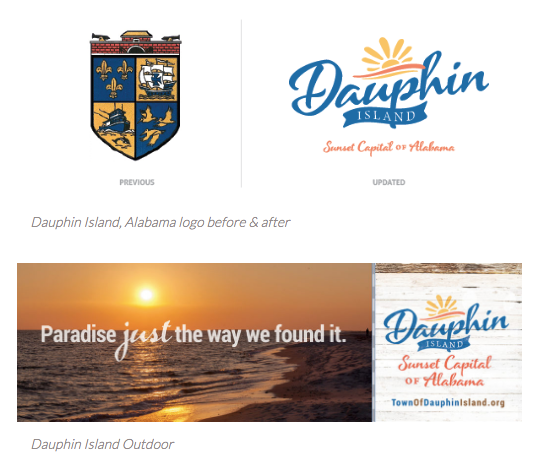
The campaign was a resounding success: "Since the launch of the campaign, Dauphin Island's Mayor reports that tourism has been increasing in the last four years by 10% to 12% each year."
Livestrong Foundation
Livestrong was faced with a rebranding challenge that could only be compared to the long, daunting climbs that once faced their founder in the Tour de France's 17th stage. They needed to distance themselves from their hero-turned-villain founder, but were hesitant to embark on a complete brand overhaul given the instantly recognizable brand equity the foundation had built globally.
The vitality inherent in the brand's bright yellow was both its calling card and a color that remained an authentic reflection of the foundation's soul — it was a core attribute the brand wished to retain. And the team at Rigsby Hull smartly realized an opportunity to reinforce one of the foundation's key messages: the foundation had never been about just one person [Lance].
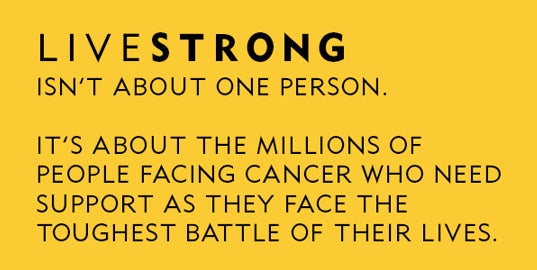
"The time is perfect [for Livestrong] to consolidate its strengths, showing that rather like battling cancer, it is how the organisation responds to adversity, finds strength and delivers a message of courage to others — which really matters," says Jonathan Gabay, author of The Brand Messiah.
The charity's overhauled logo dropped Armstrong's name and instead reinforced the concept of community by emphasizing the word "Foundation," which is set slightly ahead of the preceding "Livestrong" to suggest progressive, forward movement.
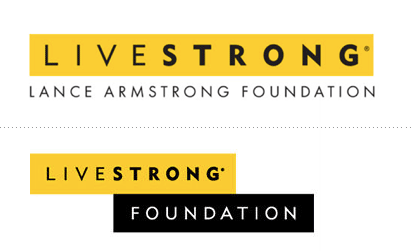
The changes to the organization's brand were subtle but substantive, while keeping the most recognizable aspects of the brand intact.
Bitter, eh?
Brands that use their founders as spokespeople put themselves in some inherent danger, according to Deb Gabor, CEO of Sol Marketing. "Both brands [Papa John's and Livestrong] put all their eggs in one basket with a single spokesperson and this automatically puts the brand at risk," Gabor told CNN Money. Perhaps most interestingly, both founders revealed their true colors in the days following their respective crises. John Schnatter sued his own company, claiming the board organized a coup against him and then launched his own website against the company's wishes: https://savepapajohns.com/. Lance Armstrong followed suit, tweeting a picture of himself alongside his seven Tour de France winning jerseys with the caption "Back in Austin and just layin' around."
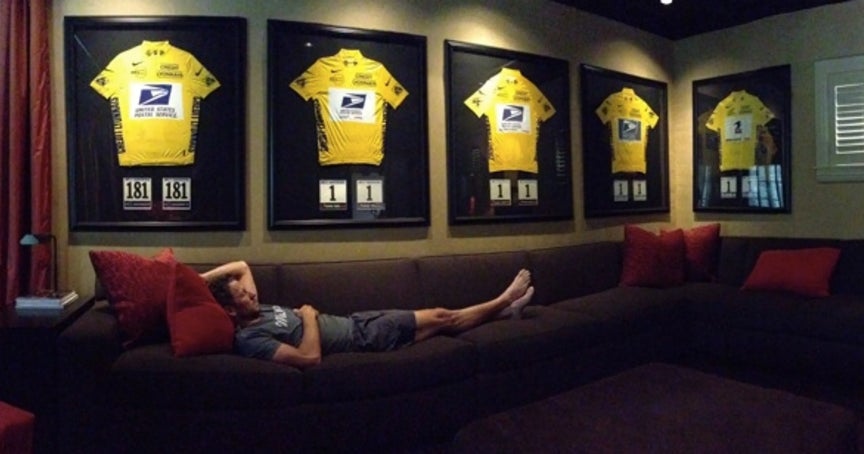
Key takeaways
- All enduring brands will at some point be faced with crisis.
- Consumers don't blame brands for situations outside of their control, but they do blame them for not having a crisis management strategy.
- Move swiftly to acknowledge the crisis, own up to mistakes, and show empathy.
- Avoid making sweeping changes (like name changes) in the heat of the moment; doing so can easily discard years of brand equity that's taken years to build.